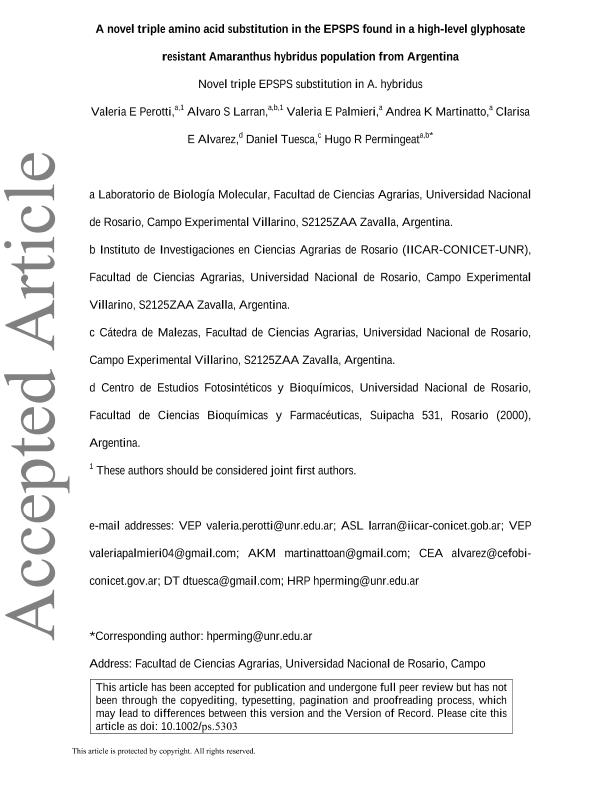Mostrar el registro sencillo del ítem
dc.contributor.author
Perotti, Valeria Elisa

dc.contributor.author
Larran, Alvaro Santiago

dc.contributor.author
Palmieri, Valeria Esther

dc.contributor.author
Martinatto, Andrea Karina

dc.contributor.author
Alvarez, Clarisa Ester

dc.contributor.author
Tuesca, Daniel
dc.contributor.author
Permingeat, Hugo Raúl

dc.date.available
2022-07-27T17:12:49Z
dc.date.issued
2019-05
dc.identifier.citation
Perotti, Valeria Elisa; Larran, Alvaro Santiago; Palmieri, Valeria Esther; Martinatto, Andrea Karina; Alvarez, Clarisa Ester; et al.; A novel triple amino acid substitution in the EPSPS found in a high-level glyphosate-resistant Amaranthus hybridus population from Argentina; John Wiley & Sons Ltd; Pest Management Science; 75; 5; 5-2019; 1242-1251
dc.identifier.issn
1526-498X
dc.identifier.uri
http://hdl.handle.net/11336/163303
dc.description.abstract
Background: The evolution of herbicide-resistant weeds is one of the most important concerns of global agriculture. Amaranthus hybridus L. is a competitive weed for summer crops in South America. In this article, we intend to unravel the molecular mechanisms by which an A. hybridus population from Argentina has become resistant to extraordinarily high levels of glyphosate. Results: The glyphosate-resistant population (A) exhibited particularly high parameters of resistance (GR 50 = 20 900 g ai ha −1 , Rf = 314), with all plants completing a normal life cycle even after 32X dose application. No shikimic acid accumulation was detected in the resistant plants at any of the glyphosate concentrations tested. Molecular and genetic analyses revealed a novel triple substitution (TAP-IVS: T102I, A103V, and P106S) in the 5-enol-pyruvylshikimate-3-phosphate synthase (EPSPS) enzyme of population A and an incipient increase on the epsps relative copy number but without effects on the epsps transcription levels. The novel mechanism was prevalent, with 48% and 52% of the individuals being homozygous and heterozygous for the triple substitution, respectively. In silico conformational studies revealed that TAP-IVS triple substitution would generate an EPSPS with a functional active site but with an increased restriction to glyphosate binding. Conclusion: The prevalence of the TAP-IVS triple substitution as the sole mechanism detected in the highly glyphosate resistant population suggests the evolution of a new glyphosate resistance mechanism arising in A. hybridus. This is the first report of a naturally occurring EPSPS triple substitution and the first glyphosate target-site resistance mechanism described in A. hybridus.
dc.format
application/pdf
dc.language.iso
eng
dc.publisher
John Wiley & Sons Ltd

dc.rights
info:eu-repo/semantics/openAccess
dc.rights.uri
https://creativecommons.org/licenses/by-nc-sa/2.5/ar/
dc.subject
AMARANTHUS QUITENSIS
dc.subject
EPSPS TRIPLE SUBSTITUTION
dc.subject
GLYPHOSATE-RESISTANCE
dc.subject
SINGLE-SEED DNA EXTRACTION
dc.subject
TIPS MUTATION, HIGH RESOLUTION MELTING ANALYSIS
dc.subject.classification
Bioquímica y Biología Molecular

dc.subject.classification
Ciencias Biológicas

dc.subject.classification
CIENCIAS NATURALES Y EXACTAS

dc.title
A novel triple amino acid substitution in the EPSPS found in a high-level glyphosate-resistant Amaranthus hybridus population from Argentina
dc.type
info:eu-repo/semantics/article
dc.type
info:ar-repo/semantics/artículo
dc.type
info:eu-repo/semantics/publishedVersion
dc.date.updated
2020-08-05T16:43:04Z
dc.journal.volume
75
dc.journal.number
5
dc.journal.pagination
1242-1251
dc.journal.pais
Reino Unido

dc.description.fil
Fil: Perotti, Valeria Elisa. Universidad Nacional de Rosario. Facultad de Ciencias Agrarias. Laboratorio de Biología Molecular; Argentina. Consejo Nacional de Investigaciones Científicas y Técnicas. Centro Científico Tecnológico Conicet - Rosario; Argentina
dc.description.fil
Fil: Larran, Alvaro Santiago. Consejo Nacional de Investigaciones Científicas y Técnicas. Centro Científico Tecnológico Conicet - Rosario. Instituto de Investigaciones en Ciencias Agrarias de Rosario. Universidad Nacional de Rosario. Facultad de Ciencias Agrarias. Instituto de Investigaciones en Ciencias Agrarias de Rosario; Argentina
dc.description.fil
Fil: Palmieri, Valeria Esther. Consejo Nacional de Investigaciones Científicas y Técnicas. Centro Científico Tecnológico Conicet - Rosario; Argentina. Universidad Nacional de Rosario. Facultad de Ciencias Agrarias. Laboratorio de Biología Molecular; Argentina
dc.description.fil
Fil: Martinatto, Andrea Karina. Universidad Nacional de Rosario. Facultad de Ciencias Agrarias. Laboratorio de Biología Molecular; Argentina. Consejo Nacional de Investigaciones Científicas y Técnicas. Centro Científico Tecnológico Conicet - Rosario; Argentina
dc.description.fil
Fil: Alvarez, Clarisa Ester. Consejo Nacional de Investigaciones Científicas y Técnicas. Centro Científico Tecnológico Conicet - Rosario. Centro de Estudios Fotosintéticos y Bioquímicos. Universidad Nacional de Rosario. Facultad de Ciencias Bioquímicas y Farmacéuticas. Centro de Estudios Fotosintéticos y Bioquímicos; Argentina
dc.description.fil
Fil: Tuesca, Daniel. Universidad Nacional de Rosario. Facultad de Ciencias Agrarias; Argentina
dc.description.fil
Fil: Permingeat, Hugo Raúl. Consejo Nacional de Investigaciones Científicas y Técnicas. Centro Científico Tecnológico Conicet - Rosario. Instituto de Investigaciones en Ciencias Agrarias de Rosario. Universidad Nacional de Rosario. Facultad de Ciencias Agrarias. Instituto de Investigaciones en Ciencias Agrarias de Rosario; Argentina
dc.journal.title
Pest Management Science

dc.relation.alternativeid
info:eu-repo/semantics/altIdentifier/doi/https://doi.org/10.1002/ps.5303
Archivos asociados
